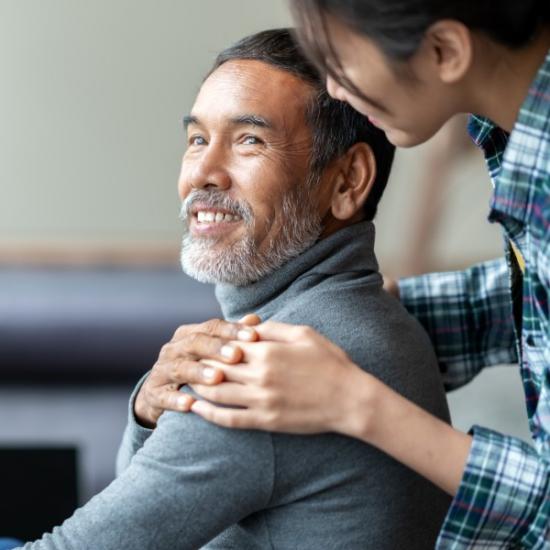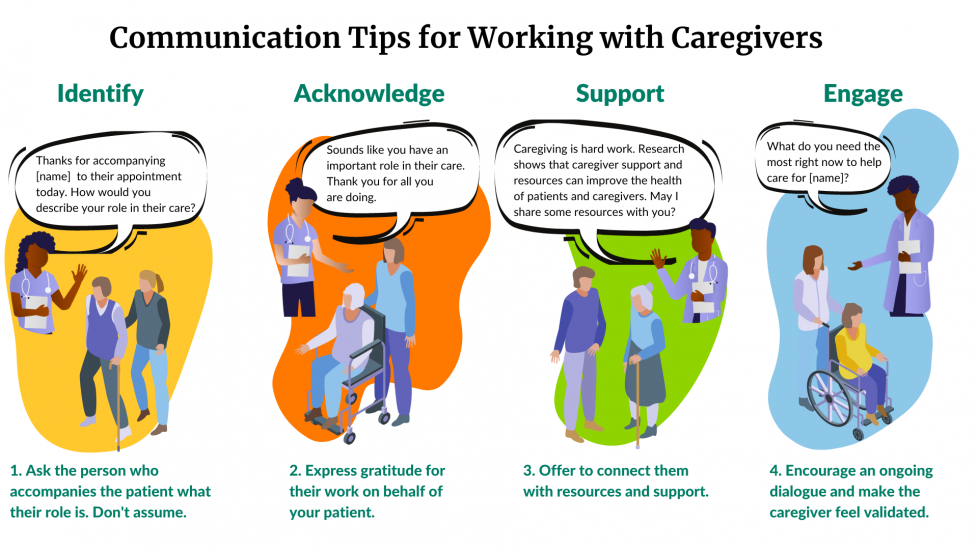Toolkit for Physicians and Caregivers on Informal Caregiving
Approximately 43.5 million individuals in the US provide informal care to an adult or child, with the vast majority caring for someone age 50 or older. The average caregiver tends to be female, college-educated, middle-aged and employed. However, there are many different kinds of caregivers of all ages and backgrounds. Caregivers are at higher risk for health problems, stress, and depression.*
An informal caregiver refers to any individual providing some form of unpaid and continuous assistance completing activities required of daily life for someone with a chronic illness or disability.
*Source: “Literature Review on the Impact of Informal Caregiving on Healthcare Outcomes Conducted by Division of Governmental Affairs and Public Policy staff for the Health and Public Policy Committee” March 2020
This toolkit shares training, best practices, and resources to help physicians partner with caregivers to improve health outcomes for both patients and caregivers.
Why Engage Caregivers?
 Engaging caregivers is an efficient and effective way to improve the health of both caregivers and patients. Simply identifying your patient’s caregiver and acknowledging their role in the care of your patient can be therapeutic. Sharing resources to inform and support caregivers can be transformative. A recent literature review done by the American College of Physicians found that the simple interventions of identifying caregivers and connecting them with support and training resources can improve the health of both the caregiver and the patient. Patients of trained caregivers were less likely to be hospitalized and trained caregivers had decreased rates of anxiety, depression, and improved quality of life.
Engaging caregivers is an efficient and effective way to improve the health of both caregivers and patients. Simply identifying your patient’s caregiver and acknowledging their role in the care of your patient can be therapeutic. Sharing resources to inform and support caregivers can be transformative. A recent literature review done by the American College of Physicians found that the simple interventions of identifying caregivers and connecting them with support and training resources can improve the health of both the caregiver and the patient. Patients of trained caregivers were less likely to be hospitalized and trained caregivers had decreased rates of anxiety, depression, and improved quality of life.
How to Identify and Acknowledge Informal Caregivers
By identifying and acknowledging a caregiver, the physician may help the caregiver and the patient feel more supported. This takes less than a minute to do!

Read above infographic as a script
Step 1: Identify the caregiver
- “Thanks for accompanying (patient name) to their appointment today. How would you describe your role in their care?”
- Communication tip: Ask and don’t assume
Step 2: Acknowledge the caregiver
- “Sounds like you have an important role in their care. Thank you for all you are doing”
- Communication tip: Express gratitude for their work on behalf of your patient.
Step 3: Offer to connect them with resources and support
- Physician: “Caregiving is hard work. Research shows that caregiver support and resources can improve the health of patients and caregivers. May I share some resources with you?”
- Caregiver: “Thanks for acknowledging my role. I’m doing the best I can right now but maybe these resources can help me do better. Please share them with me.”
- Physician: “Here are a list of websites. Please let me know if you find any of them helpful for you.”
- Caregiver: “Do you think I need the resources because I’m not doing a good enough job?”
- Physician: “Absolutely not. I’m sharing them with you because everyone needs support sometimes and caregiving can be very challenging work.”
- Communication tip: Acknowledge that caregiving is challenging work.
Step 4: Further engage the caregiver
- Physician: “What do you need the most right now to help care for (patient name)?”
- Caregiver: “Are there options available to help me get a break from caregiving?”
- Physician: “Absolutely, everyone needs to take break periodically. Here is a link to information about how to access respite care.”
- Caregiver: “I’m have trouble juggling caregiving with my job. I’m working nights but still it’s a lot”
- Physician: “That does sound like a lot! Have you considered taking a leave of absence from your work? I’d be happy to complete the medical certification for your employers Family Medical Leave Act (FMLA) forms if you are interested.”
- Caregiver: “I would like more training on how to do safer transfers from the chair to the bed and bed to the bathroom”
- Physician: “Transfers are a common source of anxiety and risk for patients and caregivers. Thanks for sharing your concern with me. These videos demonstrate tips for safer transfers and there are some in person training courses available as well. Let me know what you find most helpful.”
- Communication tip: Encourage an ongoing dialogue and make the caregiver feel validated.
Testimonial
- Dementia Care Not Just a Prescription - Dr. Catherine DuBeau (ACP Member) is interviewed in an Internist article emphasizing importance in checking in on caregivers.
Videos
- Helping Family Caregivers Through Difficult Situations (video, 5:23) - This video provides advice to physicians on how to better identify and incorporate family caregivers in health care process (specifically in hospital discharge).
- Connecting the Dots for Caregivers - Watch this short video to learn more about ways to have more engaging conversations with caregivers. Caregivers often respond differently to physicians’ questions when they are not in front of the patient.
- Sample of effective communication between a clinician, caregiver, and patient - Effective communication between patients, family members and clinicians can increase understanding of why certain practices are important to follow once the patient leaves the hospital.
Resources
Access these resources to help you better identify and recognize caregivers in your practice setting.
- Being a Caregiver Has Made Me a Better Doctor – This KevinMD blog post from a physician touches on changes he made to his practice after helping a spouse through cancer.
- When Doctors Become Caregivers – This AARP article interviews 4 doctors on changes they made to their practice after they became family caregivers.
- My mother has Alzheimer’s: a caregiver’s story – This KevinMD podcast (17 min) interviews a family caregiver, including providing advice to clinicians for interacting with caregivers.
- Next Steps in Care – Next Step in Care provides easy-to-use guides to help family caregivers and health care providers work closely together to plan and implement safe and smooth transitions for chronically or seriously ill patients.
Additional Resources for Clinicians
- Talking With Your Older Patient – This booklet, developed by the National Institute on Aging, provides effective techniques for clinicians and other healthcare professionals on communicating with older patients.
Information on filling out FMLA forms
- Sample FMLA form – This is a sample FMLA form that employees caring for an ill family member need to complete.
- Physicians must complete section III of the form which includes Medical Information (Part A- limit response to the medical condition for which the employee is requesting leave) and Amount of Leave Needed (Part B- provide your best estimate and make sure it is consistent with Part A). Please note that some state or local laws may not allow disclosure of private medical information about the patient’s serious health condition, such as providing the diagnosis and/or course of treatment.
- Here are some basic definitions that should help with completing the forms:
- Serious health condition: an illness, injury, impairment, or physical or mental condition that involves inpatient care or continuing treatment by a health care provider.
- Incapacity: the inability to work, attend school, or perform regular daily activities due to the condition, treatment of the condition, or recovery from the condition.
- Medically necessary care: assistance with basic medical, hygienic, nutritional, safety, transportation needs, physical care, or psychological comfort.
Adult Protective Services – How and When to File If You Suspect Caregiver Abuse
- What APS Reporters Need to Know – This fact sheet from NAPSA explains what APS reporters need to know.
- Adult Protective Services, What You Must Know – This fact sheet from the National Center on Elder Abuse outlines information on adult protective services as well as an FAQ on reporting to APS.
Telemedicine and Caregivers
- Factoring in Caregivers Adds Value to a Telehealth Program - Telehealth programs that include the caregiver in the care management process stand a better chance of improving outcomes and quality of life.
- Using Telehealth to Improve Home-Based Care for Older Adults and Family Caregivers - Older adults with complex care needs want to live as independently as they can for as long as they can, and limit stress on family caregivers. Telehealth strategies offer the potential to improve access to care and the quality of care, while reducing strain on family caregivers.
How to Connect Caregivers With Resources
 There are many caregiving organizations, networks, alliances, and agencies throughout the US that produce free, high-quality, easily accessible training and support resources. The simple act of sharing a list of relevant websites with a caregiver may encourage them to reach out for help and support and motivate them to enhance their skills. Below are some resources you might consider sharing.
There are many caregiving organizations, networks, alliances, and agencies throughout the US that produce free, high-quality, easily accessible training and support resources. The simple act of sharing a list of relevant websites with a caregiver may encourage them to reach out for help and support and motivate them to enhance their skills. Below are some resources you might consider sharing.
Resources
Use these resources to inform how you provide training to caregivers and share these take home tools with caregivers you come into contact with in practice.
General Help and Tools
- AARP Prepare to Care: A Caregiving Planning Guide for Families – AARP’s Prepare to Care Resource Guides are designed to help develop and implement a caregiving plan for a loved one or friend. The guides includes information on how to have vital conversations, ways to assess a loved one's needs, tips for organizing important documents, a roundup of federal and national resources, information on caring for yourself, and checklists, medication charts and contact lists. Downloadable/printable resources
- FDA Tips for Caregivers - FDA Office of Women’s Health understands caring for someone can be rewarding but challenging. FDA’s Tips for Caregivers website provides tools to help caregivers manage the care of their loved ones. The website provides tips for caregivers of older adults, young children, teens and people with special needs. The website also highlights tips for all caregivers to know. Downloadable/printable resources
- Eldercare Locator – The Eldercare Locator, a public service of the US Administration on Aging, is the first step to finding resources for older adults in any US community. Just one phone call or website visit provides an instant connection to resources. The service links visitors to state and local Area Agencies on Aging and community-based organizations that serve older adults and their caregivers.
- Caregiving Resources from the National Alliance for Caregiving – The National Alliance for Caregiving partners with other caregiving associations and groups to provide additional resources to help family caregivers address and cope with the challenges of caring for a loved one.
- Family Caregiver Alliance - Established in 2001 as a program of Family Caregiver Alliance, the National Center on Caregiving (NCC) works to advance the development of high-quality, cost-effective policies and programs for caregivers in every state in the country. Uniting research, public policy and services, the NCC serves as a central source of information on caregiving and long-term care issues for policy makers, service providers, media, funders and family caregivers throughout the country.
- National Family Caregiver Support Program - The National Family Caregiver Support Program (NFCSP), established in 2000, provides grants to States and Territories, based on their share of the population aged 70 and over, to fund a range of supports that assist family and caregivers to care for their loved ones at home for as long as possible.
- Alzheimer's Association – The Alzheimer’s Association has a broad variety of resources for caregivers of patients with Alzheimer’s or dementia including early and late stage guides, training resources, and links to support groups. Downloadable/printable resources
- How to Tell When a Loved One Needs More Care Than What You Can Give Them - Here are a few of the first signs that your loved one might need more care than you can give them.
- Tough Conversations with Aging Loved Ones – This guide will help you navigate some of the most crucial talks you should have with an aging loved one as well as extensive expert advice on how to best broach these challenging topics.
Emotional Support
- Caring.com – Caregiver support and resources including support groups, organizations to know about, and links to caregiver books, blogs, and podcasts.
- Caregiver Action Network - Caregiver Action Network (CAN) serves a broad spectrum of caregivers ranging from the parents of children with special needs to the families and friends of wounded soldiers. CAN is a nonprofit organization providing education, peer support, and resources to family caregivers nationwide free of charge. Resources from the Caregiver Action Network, including a Peer Forum, a Story Sharing platform, the Family Caregiver Tool Box and more.
Financial Support
- Financial Steps for Caregivers: What You Need to Know About Money and Retirement – This handout is designed to help you identify financial decisions you may face as a caregiver. The decision to become a caregiver can affect both your short-term and long-term financial security, including your own retirement.
- Meals on Wheels - Meals on Wheels operates in virtually every community in America to address senior hunger and isolation.
- Aunt Bertha - Find food assistance, help paying bills, and other free or reduced cost programs.
Respite Care
- What is Respite Care? – Information on respite care and other important resources from the National Institute on Aging.
Transitions of Care/Palliative Care
- Palliative Care Provider Directory - The Palliative Care Provider Directory is a resource to help you or a loved one locate palliative care in your area. It includes all programs that have listed themselves with GetPalliativeCare.org. Please contact the palliative care program directly to confirm eligibility.
- What Caregivers Should Know About Palliative Care – This article from the AARP helps caregivers understand the benefits of palliative care, how to get palliative care and how to pay for it.
- Mapping Community Palliative Care – This report from the Center to Advance Palliative Care’s three-year national research project conducted in collaboration with the National Coalition for Hospice and Palliative Care, is the first nationwide scan of community palliative care programs.

